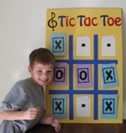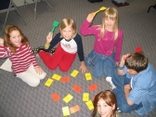Monkey Fingers
This game is useful in teaching finger numbers and LH and RH.
Have 2-3 students stand in front of a table with a bell in the center of them. Place finger numbers 1-5 and a LH/RH in front of each student.
 Stand with your back facing the students. Place a finger puppet (in this case a monkey) on one of your fingers.
Stand with your back facing the students. Place a finger puppet (in this case a monkey) on one of your fingers.
Show the students your fingers.
 Students should find the correct hand and finger number, place it in front of them and ring the bell.
Students should find the correct hand and finger number, place it in front of them and ring the bell.
Name That Tune
This is a classic that young and old students love. I have created worksheets to be used by teams so that the game is more pedagogically benficial. The worksheets belowinclude questions on Major/minor, time signature, tonic dominant, intervals, etc.
How to play
Select a number of familiar melodies to play for students (Christmas melodies are fun here). Divide students into 2 teams and instruct them to work together to find the answers to the questions on the worksheet. If necessary, explain what “tonic/dominant” mean, as well a other terms on the worksheet. After playing the tune (or parts of the tune) several times, have the teams report on their answers to see which team has the most correct answers.
Bingo
Kids and adults never seem to tire of this game!
Bingo Level 1 (RH, LH, dynamics, clefs, note values, etc.)
Bingo Level 1 Call
Bingo Level 2 (accidentals, articulations, note values through eighths, etc.)
Bingo Level 2 Call
Treble Clef Game
Natalie gave me the idea for this board.
 Supplies:
Supplies:
Poster Board
Game markers (borrow some from Monopoly if you don’t have any)
Interval Dice (see below under dice)
Stinky Sox Cards
1-inch circles (2 different colors) placed in the shape of a treble clef (as pictured)
How to play
A student rolls the interval dice and advances the distance of the interval (Make sure they count the circle they start on, just as we count intervals!) If the student lands on a BLUE circle, they draw an easier Stinky Sox card and follow the directions. If they lands on a RED circle, they draw a more difficult Stinky Sox card. If they answer correctly, they get a free roll (but do not have to draw a card).
Note…The nice thing about this game is that you can have several different levels of students playing at once. To do this, sub-divide the Stinky Sox cards into several different stacks depending on level of difficulty. For example, if you have both elementary students and intermediate students playing, you would have a stack of easy cards for the elementary students, and a different stack of easy cards for the intermediate students. You would do the same for the difficult cards for both levels.
Tic-Tac-Toe
Though you don’t have to have this game board to play, it sure is exciting for the students!
 Supplies for Board
Supplies for Board
1 foam board (available at Walmart now!)
Library pockets
Velcro
1 inch strips of poster board (to make the grid)
Glue
Supplies for the game
Stinky Sox cards or a set of flashcards with concepts that you wish to review. (Stinky Sox cards are great for this because they require the students to complete ia project in 1 of 4 areas: singing, playing, acting, and answering theory questions)
Tic-Tac-Toe Cards (these cards are designed to be printed on 4×6 index cards)
How to play
Place 9 flashcards face down on the table or in the pockets or on the board. Have 1 student from the first team pick a card and correctly identify it. If they get it correct, they can place an X (or O) on that flashcard (or if you are playing with the Tic Tac Toe board, the student will velco the X or O on the pocket). Keep alternating teams until someone has 3 in a row.
(I am always amazed at how many students love this simple game! Sometimes, I play it in private lessons with them. Even though I will always get the terms right, they still enjoy the challenge of getting 3 in a row.)
Interval Whackers
 Buy a set of mini-fly-swatters for endless fun! Find them here.
Buy a set of mini-fly-swatters for endless fun! Find them here.
Place interval flashcards on the floor and seat students around the flashcards. Call out (or play a) “2nd”, “3rd,” etc. and whoever “whacks” the interval first wins!
Variations:
Whacking piano key cards
Start down the letters of the musical alphabet and have them whack the letter that comes after you stop
Name a note and have them whack a note a 3rd or a 4th higher
Whack triads
Pictures of composers
Play an musical excerpt and whack the composer!
Fun with a Stopwatch
The stopwatch was been a magical item in my studio!
For those young students who have a hard time staying on track to find their own hand position, I say, “Let’s see how long it takes you to find the hand position on this piece.”
For those students who have to take a bathroom break in the middle of the lesson, “Let’s see how quickly you can come back!”
Other ideas…
“Let’s see how quickly you can finish this theory page.”
“I’ll give you 1 minute to silently prepare this section of the piece. Let’s see if you can sight-read it perfectly.”
“How fast can you play all the A’s on the piano? Let’s see if we can beat that time next week.”
“1-minute club.” This idea came from Jane Bastien (years ago at a workshop) and the idea is to have each student be a member of the 1-min. club by saying and playing all of the note name flashcards at the piano. (30 cards for the notes from very low C to very high C) Fewer cards can be used for beginners or more added for higher level students.
Dice Games
Supplies
Dice (get 1″ wooden squares from a hobby store)
Click here to get the materials to make the Dice (intervals, white keys, up/down, etc.).
Game markers (can be found at hobby or teacher stores)
White Keys Dice
Use the White Keys Dice…Letters to help the student locate the note on the keyboard, and the keyboard to help the student quickly name a note.
There are all sorts of uses for these die.
1. Position the student(s) a given distance away from the keyboard.
2. As soon as a student rolls the letter dice, time the student with a stopwatch (if they are alone) or have students race to see who can play the correct note on the keyboard.
This next game can be played away from the keyboard.
1. Time the student for 60 seconds to see how many times he can roll the keyboard dice and name the note rolled accurately. This works best if the teacher keeps track of how many answers are correct.
2. Have the student try to beat his previous time at the next lesson.
Steps/Skips Dice
Use the Up/Down Dice and the Steps/Skips Dice. (See link above.)
Place game pieces on C.
The first player rolls both die. They will advance based on what the die say. (However, I never let the student go down past the starting note.)
Players alternate turns, rolling both die each time.
The first person to __ wins (set this goal at the beginning of hte game depending on the time you have).
Interval Dice
Use the Up/Down Dice and the Intervals Dice
Play continues as with the previous game, only you may want to make the destination note further up the keyboard.
Half Step/Whole Step Dice
Use the Up/Down Dice and the Half/Whole dice. (See link above.)
Play continues as with the previous game, only you may want to make the destination note G (it would take a while to get past G).
Do you have a variation on these games that you would like to share? Please email me your idea and I will post it for others to see!
Affirm-a-Term
This game is great for late elementary to advanced students. Similar to Taboo, students will divide into 2 teams. A designated “caller” will describe the word on the card while other team members try to guess the term. Players may act, sing, or use words to communicate.
Order your PDF Affirm-a-Term cards here. Perfect for teenagers!
Steal the Bacon
Supplies
2 sets of intervals flashcards, note flashcards, or other such flashcards
“Bacon” (a beanbag, or any object)
How to play
Line up the 2 teams, facing each other (this works best with 6 or more people)
Give each member of the team a flashcard and each member of the other team the same set of flashcards. Have the teams study the flashcards so that they know what their interval is. Call out an interval/note/ term. The 2 team members that have this interval will race to the middle, steal the bacon, and run back past their line.
Challenge!
Supplies
1 call bell
Flashcards (Major/minor keyboard flashcards now available!)
How to play
Place the bell on a table between 2 students. Instruct the students to keep their hands behind their back until they know the answer. After you show them a flashcard, the student who knows the answer rings the bell. If they are correct, another student comes to stand beside them to challenge them.
Players: 2-any number
Ages: All (My high school students really like this game.)
Concepts to review: All concepts are game here. But, drilling major and minor chords and intervals is especially effective. I use Major/Minor Flashcards to drill chords and a cloth staff with circles for notes to drill intervals.

Nice games – feel very excited to play some of them with my own students! Love the fly swatter game! I play with note flashcards slightly differently though (because I mostly do one on one teaching) – I do the one player, and we try to go through the whole pile of cards, if the student guesses a note wrong – it goes into the wrong pile. We revisit the wrong pile until they guess all the notes in the pile correctly. They are timed, and they have to try to beat their own personal record. I’ve noticed that most of your games are for groups, in that circumstance I make it like an Olympics – split them up into groups according to age and ability, and then have them compete against each other, trying to beat each others scores. It’s a lot of fun!
Those are great ideas, Rebecca! Thanks so much for taking the time to share them.
Wendy, I discovered your site last school year when I was looking for some rhythm resources for my band, choir, and guitar students. This year I have added a beginning percussion ensemble class, and of course we need to start with basic rhythms, and your rhythm sheets are great! I have been using them shamelessly and have been quite happy with the results. The percussion class has become quite good at reading rhythms in the first two weeks of school. The trick with them is to use proper stick technique while playing the correct rhythm. We have just started to increase the tempo. I can’t wait to starry the two part rhythm sheets, and we will revisit them when we get out the mallet instruments. I’m thinking marching bass drums with some snare drums and tenors in the other hand. I am also going to include some of your games, especially the bingo games. They will work well with the terminology.
Thanks for sharing your pedagogical resources!